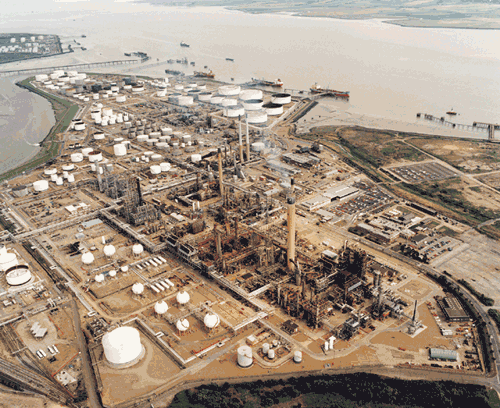Commissioned 1953 | Decommissioned 2012 (2012) Founded 1953 | |
 | ||
Country England, United Kingdom | ||
Coryton Refinery was an oil refinery in Essex, England, on the estuary of the River Thames some 28 miles (45 km) from the centre of London, between Shell Haven Creek and Hole Haven Creek, which separates Canvey Island from the mainland.
Contents
- Coryton refinery
- Explosives factory
- Oil storage depot
- Refinery
- BP
- Petroplus
- Shutdown
- Deepwater fuel import terminal
- Process units
- Statistics
- Fire
- References
It was a part of the Port of London and was the last of the three major refineries on the Thames Estuary to remain in operation. Output was delivered by road, sea and rail, and it was linked to Stanlow Refinery in North West England by the UK Oil Pipeline (UKOP). There is a 753 MW gas-fired power station, opened in 2002 and run by Coryton Energy Co Ltd, part of Intergen.
In January 2012 Petroplus filed for bankruptcy. Coryton Refinery ceased production in June 2012. The site will be turned into a distribution terminal to be called Thames Oil Port.
Coryton refinery
Explosives factory
In 1895 the ammunition firm Kynochs built an explosives factory at the site. This opened in 1897, with an estate for employees called Kynochtown. Products included cordite, guncotton, gunpowder, and cartridges. Kynochs also built the Corringham Light Railway (CLR), with a passenger branch from the works to Corringham and a goods branch to the London, Tilbury and Southend Railway at Thames Haven. The Kynoch works closed in 1919.
Oil storage depot
The site and CLR were taken over by coal merchants Cory Brothers Ltd of Cardiff to build an oil storage depot, with Kynochtown renamed Coryton. Sources differ as to whether Corys, who sold a well-known brand of petrol, Corys' Motor Spirit, also built a refinery at the site.
Refinery
In 1950 Coryton and the CLR were sold to the American Vacuum Oil Company, later Mobil. The CLR to Corringham was closed, but the branch from Thames Haven was upgraded to main-line standards. A new refinery came on stream in 1953. Coryton village was demolished and absorbed into the refinery site in the 1970s.
BP
Coryton was operated by BP from 1996, when Mobil's fuels operations in Europe were placed into a joint venture with BP. Following the merger in 1999 of Mobil with Exxon, the remaining interest in the refinery was sold to BP in 2000.
Petroplus
In 2007 the plant was sold by BP to Petroplus for £714.6m (around $1.4 billion).
On 24 January 2012 it was announced that Petroplus had filed for bankruptcy, putting the refinery's future into doubt. To alleviate a possible surge in fuel prices, oil supplies were ordered from other refineries in the UK, such as the Stanlow Refinery via the UK oil pipeline network. Shipments from Coryton resumed on 26 January following agreements signed by the administrators.
Shutdown
On 28 May 2012 it was announced that the refinery would close due to PricewaterhouseCoopers, the administrators, having failed to find a buyer. Igor Yusufov's Energy Investment Fund was the only potential bidder ready to keep the refinery operating. On 28th Feb 2013 the gas supply to the site was shut off. Around twelve hours later the flare went out, bringing to an end over 60 years of operations at the refinery.
Deepwater fuel import terminal
The refinery will be turned into a diesel import terminal by Vopak, Shell and Greenergy. It will initially have a capacity of 500,000 cubic metres (18,000,000 cu ft).
Process units
Their main operating units were:
Statistics
Crude oil was received from tankers of up to 250,000 tonnes deadweight (DWT). In 2005 BP acquired a fleet of three new 32 m tugs for towing, mooring, fire-fighting and pollution control at the plant. They ware named 'Corringham', 'Stanford' and 'Castle Point' after nearby locations.
Refining capacity was 11 million tonnes per year or 220,000 bbl/day.
Product output:
Fire
A major fire occurred on 31 October 2007. Despite the scale of the blast, which was reported to cause buildings to shake 14 miles (23 km) away, there were no physical injuries and only partial disruption to the refinery.
